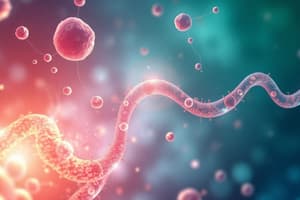Podcast
Questions and Answers
What is the main purpose of drug metabolism?
What is the main purpose of drug metabolism?
- To convert lipid-soluble drugs to water-soluble for excretion (correct)
- To increase drug toxicity
- To change free drugs to bound form
- To activate inactive drugs
Which barrier allows only lipid-soluble, less-ionized drugs to pass through?
Which barrier allows only lipid-soluble, less-ionized drugs to pass through?
- Blood-brain barrier (correct)
- Liver barrier
- Meninges barrier
- Placental barrier
Which phase of drug metabolism involves oxidation, reduction, and hydrolysis?
Which phase of drug metabolism involves oxidation, reduction, and hydrolysis?
- Phase IV
- Phase I (correct)
- Phase III
- Phase II
Which organ is NOT mentioned as a site of drug metabolism?
Which organ is NOT mentioned as a site of drug metabolism?
What is the possible outcome of drugs passing through the placental barrier?
What is the possible outcome of drugs passing through the placental barrier?
Which type of drugs can pass through inflamed meninges?
Which type of drugs can pass through inflamed meninges?
How does drug metabolism contribute to drug excretion?
How does drug metabolism contribute to drug excretion?
What is a common consequence of some drugs displacing others from their binding sites?
What is a common consequence of some drugs displacing others from their binding sites?
Which type of drugs can pass through the blood-brain barrier?
Which type of drugs can pass through the blood-brain barrier?
What is one of the functions of Phase II drug metabolism?
What is one of the functions of Phase II drug metabolism?




